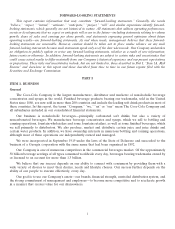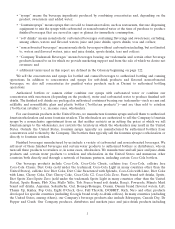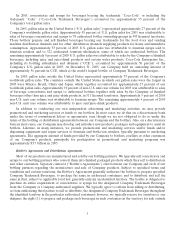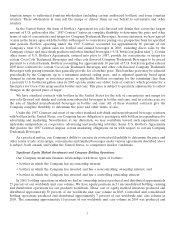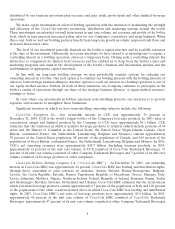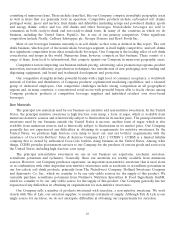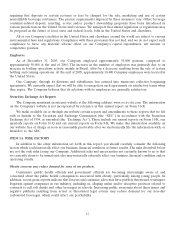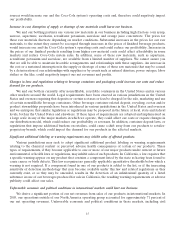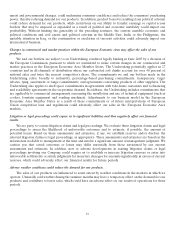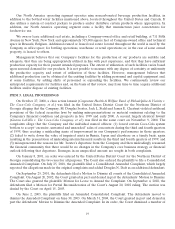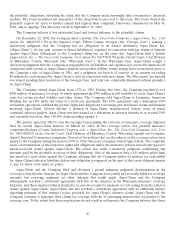Coca Cola 2005 Annual Report Download - page 13
Download and view the complete annual report
Please find page 13 of the 2005 Coca Cola annual report below. You can navigate through the pages in the report by either clicking on the pages listed below, or by using the keyword search tool below to find specific information within the annual report.With regard to juice and juice-drink products, citrus fruit, particularly orange juice concentrate, is our
principal raw material. The citrus industry is subject to the variability of weather conditions. In particular,
freezing weather or hurricanes in central Florida may result in shortages and higher prices for orange juice
concentrate throughout the industry. Due to our ability to source orange juice concentrate from the Southern
Hemisphere (particularly from Brazil), the supply of orange juice concentrate available that meets our
Company’s standards is normally adequate to meet demand.
Patents, Copyrights, Trade Secrets and Trademarks
Our Company owns numerous patents, copyrights and trade secrets, as well as substantial know-how and
technology, which we collectively refer to in this report as ‘‘technology.’’ This technology generally relates to our
Company’s products and the processes for their production; the packages used for our products; the design and
operation of various processes and equipment used in our business; and certain quality assurance software.
Some of the technology is licensed to suppliers and other parties. Our soft-drink and other beverage formulae
are among the important trade secrets of our Company.
We own numerous trademarks that are very important to our business. Depending upon the jurisdiction,
trademarks are valid as long as they are in use and/or their registrations are properly maintained. Pursuant to
our Bottler’s Agreements, we authorize our bottlers to use applicable Company trademarks in connection with
their manufacture, sale and distribution of Company products. In addition, we grant licenses to third parties
from time to time to use certain of our trademarks in conjunction with certain merchandise and food products.
Governmental Regulation
Our Company is required to comply, and it is our policy to comply, with applicable laws in the numerous
countries throughout the world in which we do business. In many jurisdictions, compliance with competition laws
is of special importance to us, and our operations may come under special scrutiny by competition law
authorities due to our competitive position in those jurisdictions.
The production, distribution and sale in the United States of many of our Company’s products are subject
to the Federal Food, Drug and Cosmetic Act; the Occupational Safety and Health Act; the Lanham Act; various
environmental statutes; and various other federal, state and local statutes and regulations applicable to the
production, transportation, sale, safety, advertising, labeling and ingredients of such products. Outside the
United States, the production, distribution and sale of our many products are also subject to numerous statutes
and regulations.
A California law requires that a specific warning appear on any product that contains a component listed by
the state as having been found to cause cancer or birth defects. The law exposes all food and beverage producers
to the possibility of having to provide warnings on their products. This is because the law recognizes no generally
applicable quantitative thresholds below which a warning is not required. Consequently, even trace amounts of
listed components can expose affected products to the prospect of warning labels. Products containing listed
substances that occur naturally or that are contributed to such products solely by a municipal water supply are
generally exempt from the warning requirement. No Company beverages produced for sale in California are
currently required to display warnings under this law. However, we are unable to predict whether a component
found in a Company product might be added to the California list in the future. Furthermore, we are also unable
to predict when or whether the increasing sensitivity of detection methodology that may become applicable
under this law and related regulations as they currently exist, or as they may be amended, might result in the
detection of an infinitesimal quantity of a listed substance in a Company beverage produced for sale in
California.
Bottlers of our beverage products presently offer nonrefillable, recyclable containers in the United States
and various other markets around the world. Some of these bottlers also offer refillable containers, which are
also recyclable. Legal requirements have been enacted in jurisdictions in the United States and overseas
11


